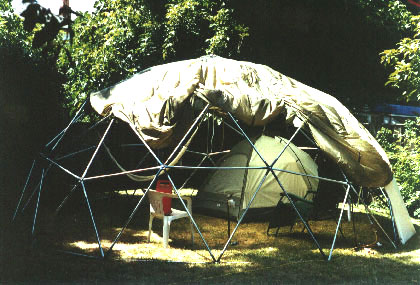| I built a 20' diameter geodesic dome using 3/4" electrical
conduit (metal pipe). It will be my home at Burning Man.
Follow the Photo Tour to see how the parts
were made and for more photos of the finished dome.
Here's some diagrams
that show how to cover a dome with tarps. I use costco tarps which are 12' x 16' at the price of 2 for $14. It
leaves a hole at the top, which is ideal for ventillation.
Attach another tarp over the hole with three permanant ropes, plus one you use to attach it at night and to pull
the top tarp on or off. A 10' sqare top tarp is idea size for an optimal 2v dome. or a 3v dome with a 16 foot diameter, etc.
I built the dome based on figures produced by
The Dome Calculator
at http://www.desertdomes.com.
Mine is a "3 frequency" dome,
built to about 3/8ths of a sphere.

I covered it
with a 35' diameter olive drab Army surplus parachute
which I purchased through Ebay. I set up my tent inside
the dome, and it nestles nicely against the curved inside
of the dome. I plan to cut remnant carpet into triangles
and place them on the floor.
|
Don't use a parachute for your dome!
The only thing that didn't work in my 2000 Burning Man
experience was trying to use a parachute for a covering.
As it turned out, a parachute has none of the right
characteristics and many of the worst possible characteristics
imaginable. Here's just a sampling of why I think
a parachute is the exact opposite of what you need for
a dome covering:
- It catches the wind and applies extra forces to your
dome. Parachutes are designed to catch the most wind
possible by weight. What you want is for wind to slip
over your dome. A parachute presses against the struts
and forms lots of tiny parachutes trying their best to
slow your dome down with respect to the wind... ;-)
- It catches the rain in pockets which form when
the material between the struts sags under the weight.
The water pours through these sagging resevoirs, drilling
holes in the playa beneath, even right through a carpet.
Parachutes are not waterproof.
- It whips mercilessly in the wind causing enough noise
that you have to raise your voice substantially to be
heard. Parachutes are loud, but offer no acoustic
insulation! Gee, could it get any worse? Yes! Read on...
- It gets tangled when you try to put it on your dome.
Believe it or not, shingling panels of silver tarps is
probably the best idea. Shingling means coving from the
bottom toward the top, and having higher tarps overlap
lower tarps. Water rolls off, and no one tarp is too
big to handle, even in the wind. Parachutes are unweildy.
- If all that isn't enough, a parachute is translucent
and traps air. In other words, your dome becomes an oven
during the day because the covering traps the sun's energy
in the air inside your dome. Parachutes form ovens, not
shade structures.
|
I also have a hammock and two awesome Lafuma reclining
chairs, a table and whatever else I have
room to bring. I want to create a chill space which is
visually private, shaded, but still with enough space to
not feel cramped. And during the night, it will be nice
to lower the canopy for privacy and warmth.
The desertdomes.com web site has an incredible FAQ about
how to build domes out of metal conduit. The FAQ surely
saved me a lot of time, frustration and wasted material.
It took me two days to produce about 130 pieces. The first
day I cut the pieces to length and flattened the ends of
about 1/3 of the pieces using a manual press. The second
day I flattened the rest of the pieces and drilled holes
in each end at just the right positions. Then I spray painted
the ends of each piece and let them all dry.
It took me three hours on the third day to assemble the
dome from pieces using 3/8" carriage bolts, fender washers,
lock washers and nuts. I needed a stepladder which was
about 3' tall to finish the top but I'll figure out
something else to stand on for Burning Man.
Once assembled it is remarkably strong! You can climb
on it, but I ask that people avoid putting their weight
on the middle of any of the pieces -- you can climb from
vertex to vertex. The triangles at the bottom are different
sizes, but the largest is just big enough for me to wheel
my bike into. :-)
The total cost of the materials for the dome was about
$200, and you can get a Parachute for about $40-$50.
Steven's Creek Surplus in San Jose had them for $40
at the time I wrote this page (7/5/2000). The rebar
for the stakes cost another $2.25 each and I needed 8.
So the total cost was less than $275. |